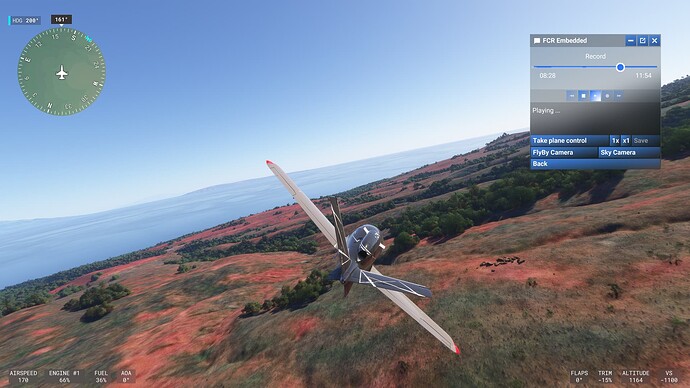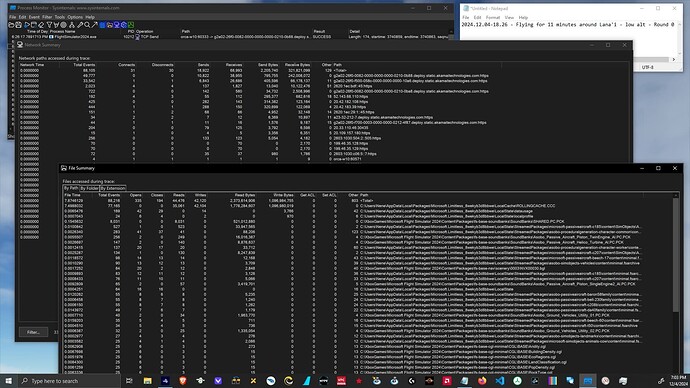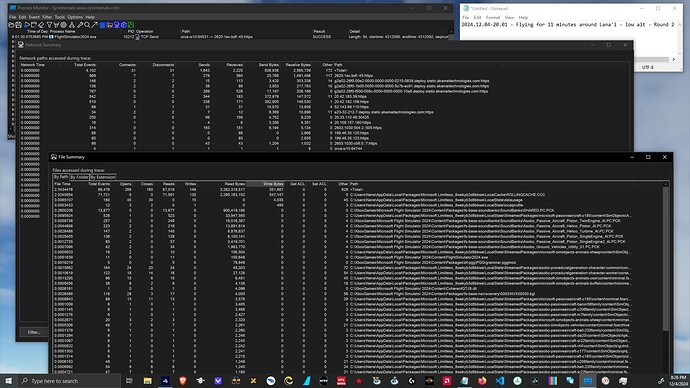2024.12.04-18.26 - v1.1.10.0 - Flying for 11 minutes around Lana’i - low alt
After the pervious 3,600 ft flight the obvious idea for the next test was: How about a low altitude flight?
- If I always fly the same short path …
- … but this time very close to the ground to force the highest resolution of landscape rendering:
- How much data will now (have to) be loaded from the servers?
- … in addition to what already is in the cache from the 3,600 ft round.
- How much data comes from the
RollingCache.cccinstead of the network?- … especially after round zero, when the cache should already be warmed up.
For that I performed the following steps … which are almost identical to the previous test:
- I used the FS2024 “FCR” tool recording round zero to warm up the
RollingCache.ccc. - I then replayed the flight three times.
- I watched each flight from the same external camera position
- … (hoping) to avoid too much data triggered by the glass cockpit
- … and to cover more landscape then from a cockpit view.
- But this time my 11:54 m:s flight, circling the small island of Lana’i (PHJH), was
- … with the Vision Jet at a slightly more moderate speed of around 170 ktas
- … and so low to the ground that I was be able to see rocks, trees, grass etc.
- … to trigger a very high (ground) LOD data demand.
So this is the camera view that I enjoyed for four times 724 seconds:
The Process Monitor recording then showed the following network and file access results. The first image has the data for round 0 (cache warmup) and the second for round 2:
My FS2024 config remained as in all the previous tests.
Similar to the last test I first want to compare the data from the 4 different round trips.
| Round 0 | Round 1 | Round 2 | Round 3 | |
|---|---|---|---|---|
| Network - Send Bytes | 2,205,740 | 2,501,717 | 838,938 | 695,372 |
| Network - Received Bytes | 321,821,099 | 284,884,657 | 2,565,739 | 19,981,048 |
| Files - All - Read Bytes | 2,373,614,906 | 2,548,535,279 | 3,282,319,517 | 2,492,714,947 |
| Files - Sound - Read Bytes | 521,012,880 | 521,012,880 | 900,418,196 | 521,012,880 |
| Files - RC - Read Bytes | 1,778,284,607 | 1,915,207,059 | 2,295,163,152 | 1,921,592,853 |
| Files - All - Write Bytes | 1,096,984,755 | 1,084,647,114 | 551,667 | 18,077,890 |
| Files - RC - Write Bytes | 1,096,980,019 | 1,084,644,155 | 547,147 | 18,074,177 |
On average (per second) over a 724 second flight the above translates to:
| Round 0 | Round 1 | Round 2 | Round 3 | |
|---|---|---|---|---|
| Network - Send Bytes/s | 3,046 | 3,455 | 1,158 | 960 |
| Network - Received Bytes/s | 444,504 | 393,487 | 3,543 | 27,598 |
| Files - RC - Read Bytes | 2,456,194 | 2,645,313 | 3,170,114 | 2,654,133 |
| Files - RC - Write Bytes | 1,515,165 | 1,498,127 | 755 | 24,964 |
For the analysis we now also have a baseline from the previous 3,600 ft test. Some aspects are identical to the 3,600 ft test:
- Files
- All data written goes into the
RollingCache.ccc. - Almost all data read comes either from the
RollingCache.cccor a local sound package.
- All data written goes into the
The major differences to the 3,600 ft test are:
- Files
- The amount of data read from the
RollingCache.cccis- around 700 to 900 KB/s … at 3,600 ft
- around 2,500 to 3,200 KB/s … at “low altitude” … so a factor 3 more.
- In “low altitude” there have been a lot less bytes read from the sound packages … a factor 2 to 3 difference.
- The amount of data read from the
- Network
- At low altitude it required flying the same path more than two times
- … before all data was streamed to the
RollingCache.ccc.
- … before all data was streamed to the
- Round 3 has reached almost the same level of bytes send as the “3,600 ft” tests.
- So this suggests that most data, that needed to be cached, actually was downloaded by now.
- At low altitude it required flying the same path more than two times
Looking just at this “low altitude” test, the positive observations are:
- Files
- All data written goes to the
RollingCache.ccc- But why was 3 times more data written then downloaded?
- Perhaps the rolling cache stores data in a preprocessed format?
- This actually could be very good news.
- If, and that is again a pure guess, if
RollingCache.cccuses the native in-memory sim engine data encoding, then bringing back data from the cache would be way faster, then the initial decoding of the streamed data.
- However, “Network Bytes” are usually counting compressed data streams.
- So maybe it just means that
RollingCache.cccdata is simply uncompressed … and not preprocessed?- That would then be bad news, as it would mainly mean wasted disk capacity.
- So maybe it just means that
- Perhaps the rolling cache stores data in a preprocessed format?
- But why was 3 times more data written then downloaded?
- All data written goes to the
- Network
- A higher LOD demand, due to lower altitude, requires more frequent updates of the landscape
- … and so naturally the volume of data send and received will go up.
- Here we see consistently a factor of around 4 to 5.
- Round 0
- Almost all downloaded data comes from “static” data servers (CDN).
- This should be the high LOD ground textures and 3D mesh data, etc. So this is expected.
- A higher LOD demand, due to lower altitude, requires more frequent updates of the landscape
The “negative” (confusing? interesting?) observations are:
- Files
- Round 1
- We can see the same large amount of writes as in round 0 … a total of 1 GB.
- This is an indicator, that a lot of landscape data was still not streamed in round 0.
- This would point to slow or overloaded backend servers (API or CDN).
- This is an indicator, that a lot of landscape data was still not streamed in round 0.
- We can see the same large amount of writes as in round 0 … a total of 1 GB.
- Round 2
- Read bytes did go up by around 0.5 GB … which is very interesting
- … as this goes hand in hand with a doubling of sound data read from disk
- … and a radical reduction of bytes that needed to be written to disk.
- In the “3,600 ft” test the demand for sound data was even higher
- … however, the total sum of bytes read form files was practically identical … 2.5 MB/s.
- So what could this all mean?
- Maybe, and this is a big “maybe”, this is a hint that the FS2024 sim uses an IO subsystem which is “priority and throughput” aware.
- If true, then that would be very good news for FS2024.
- Think of it as an “auto LOD” feature, but just for file IO operations.
- … as this goes hand in hand with a doubling of sound data read from disk
- Read bytes did go up by around 0.5 GB … which is very interesting
- However, why are we seeing the same disk read of 2.5 MB/s … even when in each round new data gets streamed.
- One might expect that with more data streamed for a certain region, more data would be read from cache on later rounds.
- This could either be a “bug” or a “feature”, depending on that is really going on inside the sim. Hard to guess from the outside, and hard to explain in a few words.
- Round 1
- Network
- Round 1
- Almost identical data volumes as in round 0.
- So there was still a lot of ground data that was not streamed, due to high latency of the request.
- On average we can see a download of 400 KB/s (4 Mbps).
- Almost identical data volumes as in round 0.
- Round 2
- The download of static data is reduced almost by a factor of 100.
- So basically no new data for the cache did arrive in this round.
- However, the send bytes are still higher then in round 3,
- … and so this indicates that the servers have been asked, but did not deliver (in time) what was requested by the sim.
- The download of static data is reduced almost by a factor of 100.
- Round 3
- The amount of downloaded static data went up by a factor 10 again
- … and so the reduction in round 2 most like was due to (too?) high latency of the backend (API or CDN) servers.
- Even after round zero to 2 there was still a small amount of data that was missing in the cache.
- The amount of downloaded static data went up by a factor 10 again
- Round 1
To summerize this test:
- Many observations of the previous “3,600 ft” test also apply to this “low altitude” test.
- Multiple low altitude flights are needed to really stream all the data for a region.
- This indicates that the backend (API or CDN) most likely is not “fast enough” yet.
- The 11 minute low altitude flight needed about 1 GB of additional landscape downloads
- … and on average 3-times more data was read from the
RollingCache.cccper second.
- … and on average 3-times more data was read from the
- Some recorded events are hard to interpret and it could either be the result of “bugs” or “features”.
- Maybe, and this is a big “maybe”, the FS2024 sim uses an IO subsystem, which is “priority and throughput” aware. Maybe.


